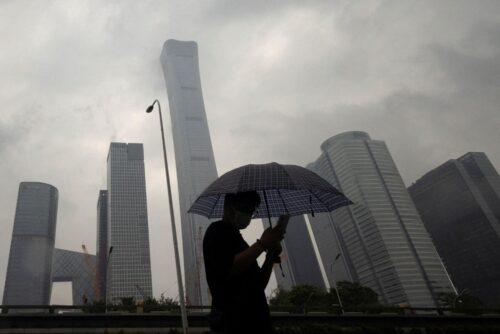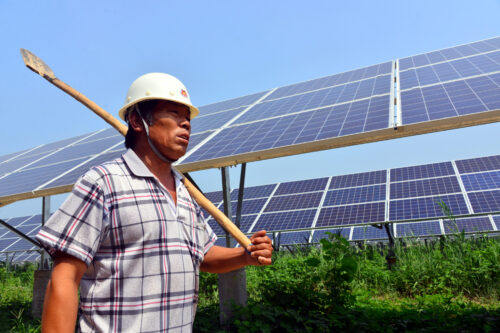Where to invest in China’s ‘common prosperity’ age
Coal, real estate, gaming and social media all look to be on their way out in China. Who are the new economic winners in Xi Jinping’s common prosperity era?

Last year, Beijing popped its once-bloated property bubble, decapitated its for-profit education sector, reversed course on some pillars of globalization like overseas IPOs, and decentered a once-thriving business of games, entertainment, and other digital indulgences. As China’s economy undergoes a tectonic shift, the losses for foreign investors were steep. According to the U.S.-China, Economic and Security Review Commission, Xi’s “Common Prosperity” agenda has already lopped off a total of $600 billion from U.S.-listed Chinese companies.
But behind the ash heap of tutors, bitcoin miners, and tech titans, lies a garden of opportunity. According to a recent report by the state-backed fund China International Capital Corporation (CICC), overseas capital inflows into Shanghai and Shenzhen reached an all-time high ($66 billion) last year. Despite the doomsday predictions, it appears that, when it comes to China, the fear of missing out trumps the danger of getting burned.
One distinctive feature of the Common Prosperity era is its socialist modus operandi: more and more, it is the state, not the market, that is driving capital. Of the top 100 financing events of 2021, state-backed funds — both from national and local governments — made up nearly 30% compared to 10% a decade ago. From 2019 to 2021, 47% of newly established funds had some affiliation with local or state governments. Beijing has never been an impartial arbiter of markets, but it used to try and keep up with appearances. Not anymore. For investors, that means the ability to discern the Party’s strategic priorities is more important than ever. The China Project finds that companies working in advanced manufacturing, the “industrial internet,” climate tech, rural revitalization, biotech, and patriotic/cultural marketing will be rewarded:
Advanced Manufacturing (and upgrades)
China hopes to move up the global value chain of highly sought-after technologies. Those sectors include batteries, electric vehicles, drones, 5G, and even space shuttles. Last year’s big tech crackdown could be read as an attempt to snap the economy back onto a STEM track after a long sabbatical in finance and cyberspace. If the first phase of Chinese growth saw a transition from atoms to bytes, the common prosperity era promises the reverse: “from virtual to real” (脱虚向实). In the past five years, manufacturing projects as a share of all financing events in China increased from 10% to 32%.
Other parts of society are gearing up for this society-wide reality check: local governments are investing heavily in vocational training and billionaire tycoons are erecting new science and technology universities in their image. Upgrades to manufacturing such as with robots are also welcome. The affordable robot maker FJDynamics scored $70 million last year to make labor-intensive industries like farming easier for workers.
China news, weekly.
Sign up for The China Project’s weekly newsletter, our free roundup of the most important China stories.
Technological “chokepoints” may be one of the more useful frameworks to conceptualize China’s future economy. Semiconductors are so scant right now that they have depressed car production and GDP. Beijing is looking for innovative small and medium-sized enterprises (SMEs) that can break supply chain bottlenecks. The Ministry of Industry and Innovation has issued no less than three notices expanding on this class of companies, which they have dubbed “specialized, refined, special and new” SMEs (专精特新). In November, ten of them debuted on the newly opened Beijing Stock Exchange, including data analytics firm Shenzhen Suntang High-tech and quartz crystal component maker AnHui Jing Sai Technology.
“Industrial Internet”
The Internet has gotten a bad rep given the latest regulatory scourges, but not all of it should be shorted. IoT applications or those in the “industrial internet,” the web of sensors, instruments, and other devices that help facilitate and enhance industrial applications from manufacturing to energy management, is aligned with Beijing’s Made in China 2025 plan that prioritizes technologies that can upgrade China’s industrial output. According to data from the think tank China Business Industry Research Institute, the industrial internet sector is set to grow from 172 billion yuan ($27 billion) in 2019 to 300 billion yuan ($47 billion) by 2024. In short, be wary of data and software that deal directly with consumers (those that spurred the delisting of ride-hailing ap Didi) and keep an eye on data and software that serves manufacturers. Many of China’s internet giants, for example, have been developing software for electric vehicles. Those subdepartments will grow larger even as their gaming counterparts will shrink.
Climate tech
2021 saw the meteoric rise of the battery giant Contemporary Amperex Technology (CATL). A private green technology company and now among the top 10 most valuable Chinese companies, CATL is the first of many. At the COP26 summit last fall, China agreed to peak carbon emissions in 2030, with zero net emissions by 2060. (To contrast, the U.S. and Europe peaked in 2005, and 1979 respectively.) The ambitious 30-year time horizon means that investors betting on sustainability projects in China will face a generous tailwind.
The path to zero-net emissions will cut through renewables like hydrogen power, wind turbines, solar energy, and adjacent industries such as EV infrastructure, batteries, and critical minerals. 2021 saw ambitious maneuvers among solar panel manufacturers such as Longi Green Energy and Xinyi Solar. From last year’s government rhetoric, the EV industry is gearing up for consolidation. In batteries and minerals, Chinese conglomerates including the cobalt maker China Molybdenum, lithium maker Ganfeng, and CATL have been on buying sprees for coveted mines and salt lakes (where lithium accumulates) all over the world.
Rural consumption
The deceleration of Chinese growth will not occur uniformly, according to Rui Ma, host of Tech Buzz China. As coastal elites and their consumption habits fall out of favor with Beijing, rural China continues to be an untapped market opportunity—especially for entrepreneurs who align themselves with common prosperity themes. “As long as the difference remains stark and a convergence inevitable [between rural and urban China],” Ma writes in The Wire, “the opportunity to capture this growth is as enticing as ever.”
Disposal income of rural Chinese is set to grow from $4,000 in 2017 to $10,000 by the end of the decade. They are hungry for quality and convenience, digitally plugged in, and far greater in number than urban Chinese. Ecommerce companies like Pinduoduo, with its famous community group buying model, have demonstrated just how lucrative catering to rural residents can be. So far, the products that make headlines like drones and electric vehicles tend to take urban Chinese as their target consumer. But more affordable items with low margins may be the way to go, as demonstrated by the record-breaking success of SAIC-Wuling’s mini-EV last year. That means stocks revolving around rural consumption — higher-end staples like meat and dairy (Muyuan Foods, Feihe, Juewei foods, etc.), household appliances (Xiaomi, Gree, Roboroc Technology), and affordable cars (BYD, SAIC, etc.) — will do well.
Biotech and affordable health care
Another preoccupation that arises from extra disposable income is awareness of health issues. True to the themes of common prosperity, the government is backing more affordable options in drugs and medical treatment while also promoting more gym teachers and sports in schools.
Meanwhile, the market is overflowing with opportunities for Chinese startups promising cutting-edge breakthroughs in the life sciences. Last year set a record for the number of Chinese biotech companies like RemGen Co that clinched licensing deals in the global biopharma industry. “Common prosperity” will herald more affordable options in drugs and medical treatment, while also moving China up the innovation ladder in biotechnology. Pharma companies with cutting-edge innovation include Beijing Tongrentang and Walvax Biotechnology.
Market Nationalism
Investors should also be attentive to rising nationalism and ongoing cultural reforms. The Xinjiang cotton row has catapulted domestic sportswear brands Li Ning and Anta Sports to new heights. In urban centers, Chinese alternatives in fashion, cosmetics, coffee, bubble tea, and other middle-class consumables will slowly challenge their foreign counterparts. They include the beverage brands HeyTea and Genki Forest, cosmetics brands Perfect Diary and Herborist, ice cream brand Chicecream, among many others. In the coming years, the “China chic” (国潮 guócháo) fad, where Chinese brands seek to out-do foreign competitors using patriotic and traditional Chinese flair, will thrive on the back of state initiatives to promote “traditional Chinese culture.”
At the annual Central Economic Working Conference in December, a high-level meeting to set the direction of China’s development path, Beijing’s top-brass rebuked growth-at-all cost capitalism but fell short of denigrating growth itself. “[Common prosperity demands] a good distribution on the basis of development, not that distribution is put before development,” said Dong Yu 董煜, the Executive Vice President of Tsinghua University China Development Planning Institute.
Indeed, investors will need to straddle a fine line in the coming years. Internet companies with large amounts of consumer data may be subject to antitrust and cybersecurity reviews (Pinduoduo, Nio, and JD.com), and companies that seem likely to set off social disruption. Those may include social media, short-form video, and gaming companies (Douban, Kuaishou, Bilibili, iQiyi). Given its role as an outlet for social criticism, social media often stands athwart, not alongside, government priorities. Nonetheless, a new economy is emerging, and those who support its incubation will be rewarded handsomely.
(See Goldman Sachs’ 50-stock common prosperity portfolio for a related review).




